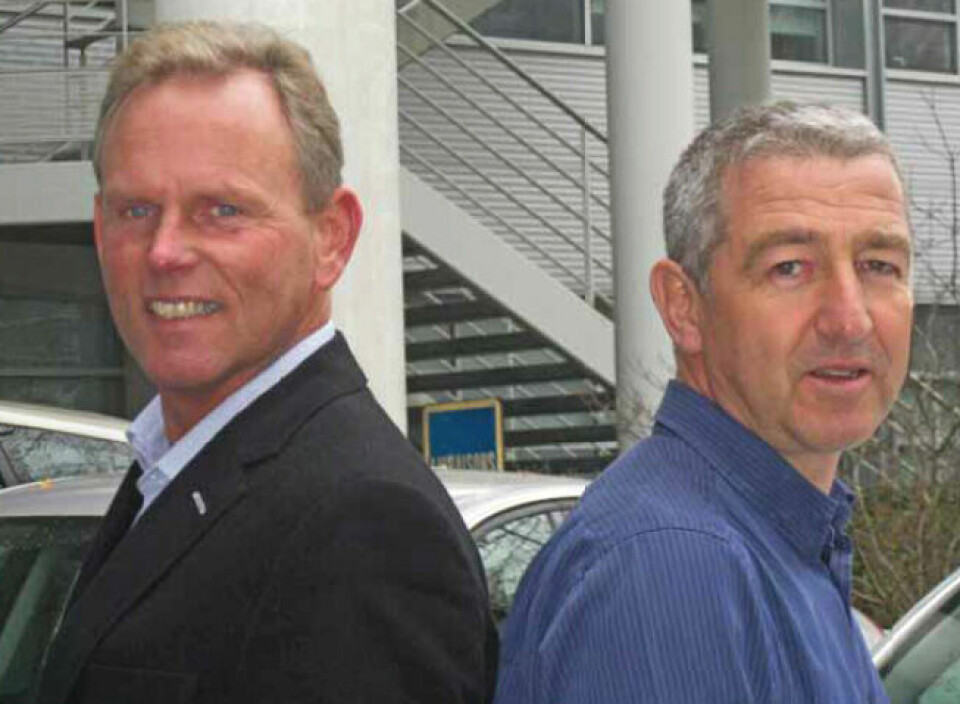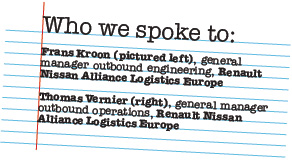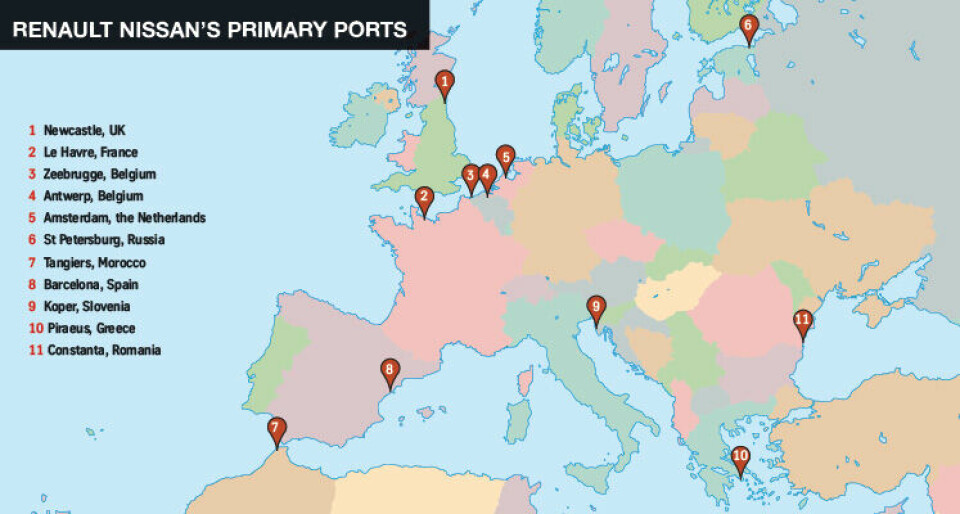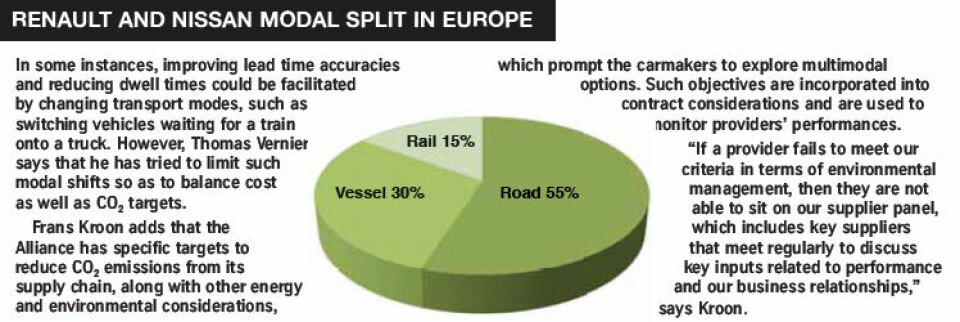Partners in search of partnership

Renault Nissan has converged more of the outbound logistics planning and operations for the two brands across the greater European region, with one of the major benefits being the use of more shared providers, reports Christopher Ludwig
Would you like to start Frans, since engineering always comes first?” So begins my interview with the Renault Nissan Alliance, as Thomas Vernier, general manager of outbound operations in Europe, gently prods his colleague, Frans Kroon, general manager of outbound engineering, to speak first. It’s a polite joke that somewhat accurately captures the division of labour at Alliance Logistics Europe, which manages logistics for Renault and Nissan’s European logistics. Typically, Kroon and his Paris-based team do indeed begin projects first, with responsibility for the design and engineering of a vehicle logistics network that represents around €700m ($940m) in annual spending across Europe, Eurasia (which includes Russia and Central Asia) and Euromed (Eastern Europe, Turkey and North Africa). However, Kroon’s team designs this network to meet the objectives and capacity demands set by Vernier, whose targets include reducing lead and dwell time so as to reduce the static inventory that the Alliance carries (and thus finances). Vernier is based in Paris, but also leads teams in Amsterdam, Newcastle, Barcelona, Bucharest and St Petersburg. Both he and Kroon report to Colin MacDonald, vice president of Alliance Logistics, and ultimately to Christian Mardrus, the managing director of the Alliance CEO office, the combined management organisation created in 2009 to accelerate the links between both carmakers.

The Alliance Logistics Global team, of which Mardrus was named managing director in 2009, brings together Renault and Nissan logistics around the world. However, the European region, with its overlapping port and sales channels, has proved to have the most potential for combined outbound planning and operations.
The Alliance Logistics Europe organisation is unique in several ways. Firstly, it represents a distinctly centralised approach to vehicle logistics planning and execution, as it dictates to providers in large degree the precise requirements for its distribution, including capacity, frequency and network optimisation. According to Kroon–whose background has been in general logistics purchasing at the Renault Nissan Purchasing Organisation and more recently in deep-sea shipping purchasing, before taking on his current role in 2011–the organisation is moving towards acting more like a 3PL between the two brands.
The Alliance is thus relying less on solutions where an outside provider would have more control over network engineering, for example. In the past, says Kroon, such outsourced solutions were common because the network was driven more by the commercial sources of supply. But today, Renault Nissan does not believe that an outside provider would be able to find the commonalities and efficiencies between the two carmakers that a dedicated management structure can. “We need to follow the engineering quotient so that we can really explain to the market how we want to organise the work,” Kroon says. “The problem with 3PLs or 4PLs in our case is that they would look to solutions that optimise one of our brands; we want a solution for both.”

Shared tenders means shared providers
Kroon admits that this transition is at an early stage, but there are nonetheless important developments. The Alliance now carries out all vehicle logistics tenders jointly, which has resulted in shared infrastructure for ports and storage, but also the use of the same providers, increasing combined transport and improving backhaul loading. In regions where newer flows or factories have been introduced, the potential for such integration and control has been realised more fully. Both Kroon and Vernier point to vehicle logistics in Russia as an example. “In Russia, where Nissan has a plant in St Petersburg and Renault has a plant in Moscow, we have really been able to take full advantage of the situation to optimise the network,” says Vernier. “We share storage and backhaul flows between the plants and we have combined the short-sea flows.” The network has also been developed completely in common for Renault’s new plant in Tangiers, Morocco, scheduled to begin production in January 2012. “It all starts with the short-sea [shipping],” says Kroon. “Taking the Tangiers example, we will integrate the Moroccan volume [at Tangiers], call into the same ports [in Europe] and then combine in the final delivery.” But integration is also continuing for more established markets. The Alliance has introduced a new north Atlantic short-sea shipping route that combines volumes from Spain, France and the UK. One benefit is that Renault volume is now consolidated with Nissan output from Spain, Mexico and the UK at the port of Tyne, near Newcastle, from where they are shipped together to Russia through St Petersburg. “This is clearly an effect of the Alliance as we improve the load factor and the frequency of the ships that we use, and also create a better connection in the north Atlantic,” says Kroon. Indeed, the trend appears now to be moving almost completely toward shared providers. The Alliance has carried out five request for quotes (RFQs) for European vehicle logistics in 2011–all of which have been done jointly–and in each case the Alliance chose the same providers for both carmakers, according to Kroon.
Combining the port network
A look at the wider Renault Nissan network already reveals considerable convergence between the shared ports of entry and exit. Deep-sea imports–which are mainly Nissans built in Japan, India, Mexico and other locations, but also imports from Renault Samsung in South Korea–are moved via the ports of Piraeus, Koper, Livorno, Barcelona, Le Havre, Amsterdam and Newcastle upon Tyne. The company also uses the port of St Petersburg transhipped via Tyne, as mentioned. These correspond largely with Renault Nissan’s main ports for deep-sea exports, which include Le Havre, Newcastle, Barcelona and Antwerp. Adding in ports for short-sea export expands the network further, including export from Zeebrugge, Constanta in Romania and, in early 2012, Tangiers. “For short-sea we are more flexible in our port network for both imports and exports, and we can switch between ports more easily than for deep-sea,” says Kroon.
“This is because there is more competition among the short-sea providers.” But the role of joint tenders continues to bring changes to the port network. For example, Renault and Nissan are now both using Le Havre for imports to the French market and subsequently they are using the same logistics providers inland. “We are also taking full advantage of backload opportunities to and from the ports,” says Kroon. For Russia, Nissan was the first carmaker to move directly to the port of St Petersburg and the Alliance retains a strong footprint around the port, together with Nissan’s factory. However, Kroon admits that, for optimisation reasons, the Alliance is studying other port options in the Baltic and elsewhere, including a southern route via the Black Sea (as Renault produces vehicles in Turkey for export as well). “But there are currently constraints in the Black Sea regarding capacity and border crossing and we have not yet made up our minds,” Kroon adds
Lowering inventory with lead times
The Alliance, like other carmakers, has faced a number of challenges in Europe in 2011, including the ongoing financial crisis and its drag on growth, in particular for some of Renault’s traditional markets such as France, Spain and Italy. With double-digit drops in some markets, sales across the broader Western European and EU markets have been flat. Further disruptions also followed the Japanese earthquake, which impacted supply for both Nissan and Renault, leading to shortages in the French OEM’s product mix, according to quarterly earnings reports.
But the Alliance has also shown resilience: Nissan’s sales have been hitting a record pace in Europe in 2011, with growth of more than 20%, including more than 50% in Russia. Renault has also been buoyed by 40% growth in Russia and the Eurasia region, 25% growth in Turkey and 12% in North Africa. Although the eurozone crisis remains an obvious worry, the Alliance has plans for expansion in the medium term, with its Tangiers factory starting production in early 2012 and new products set for production at the Avtovaz factory in Russia at the end of 2012.
In light of these expansion plans, the Alliance is aiming to improve the speed and efficiency of its vehicle logistics. “The biggest challenge from a vehicle logistics engineering perspective will be having the right capacity to comply with our mid-term plans and make sure that we can enable the objectives of Thomas and his team,” says Kroon. Indeed those objectives are–and will be–demanding, particularly in an uncertain market. “The key words are capacity and flexibility, as the customers are not always exactly where we think they will be and we need to adapt to that,” Vernier says.
Vernier also stresses the critical role that vehicle logistics can play in reducing capital financing costs, as accurate and well-planned distribution helps to lower vehicle inventory. “Since the 2009 crisis, one of our major focuses has been on shortening lead times as much as possible so as to reduce inventory,” he says. “In particular, we have been looking more carefully at the cars in the pipeline and how we can better plan that distribution in advance with providers.” Three years ago, Vernier says, if a car was produced in advance by a factory, it was not uncommon for that vehicle to sit for weeks, whereas now Renault and Nissan have improved visibility on such production. To achieve this, Vernier says that the Alliance has developed several internal tools to better monitor non-moving stock and highlight these vehicles to logistics providers. In necessary cases, he says that cars with a wide disparity between their order-to-delivery dates and the actual dispatch can be assigned priority, but the Alliance is working to build a more efficient planning and communication regime that would shorten the order-to-delivery cycle.

Outbound has not caught up with inbound
For Vernier, improving the lead-time accuracy for outbound appears to be a product of his background. Before he came into vehicle logistics in 2009, he worked for Renault in powertrain and various aspects of parts logistics. It was Vernier who started Renault’s international consolidation centre in Romania, a much vaunted and emulated operation that serves global material flows for Renault’s Logan production. He’s also had responsibility for inbound logistics to all of Renault’s European factories. To put it simply, he has come from a supply chain world of low inventory levels, highly efficient load factors and very precise delivery windows. But he admits outbound still has ground to make up to match the on-time delivery and load efficiency of inbound. For example, the crossdocking principles that have worked so well for Renault on the inbound side to improve trucking and rail movements for longer distance movements from locations like Romania, do not readily translate for outbound. He gives an example of an attempt to move cars in Europe by rail without using block trains, in which smaller loads were consolidated for onward distribution. But the results proved unreliable for lead times. “It would have been the same principle for inbound, where we use some crossdocks to maximise the loads and it works very well,” he says. “But with vehicle distribution there are still a lot of possible improvements.”
Vernier adds that the Alliance has had plans to develop a system of more precisely scheduled transport for factory pickups and delivery to further minimise the amount of static inventory. However, following supply disruptions–mainly from the Japanese earthquake–implementing the system has been pushed back. “For scheduled transport deliveries we need to have a very high efficiency in terms of on-time delivery from factories and this year the Japan crisis made that very difficult because of production disruptions,” he admits. “As soon as we have more stability we will restart this project.”
Is the best yet to come for rail?
The Alliance’s demand for vehicle logistics in Europe is considerable at €700m a year. Vernier’s push for lead time improvements and reduced dwell time translates into higher demand, as does the expansion of manufacturing in Russia, Romania and Morocco. But neither Vernier nor Kroon is currently worried about the availability of transport capacity, nor do they see the lack of investment among European vehicle logistics providers as a major issue, particularly amidst the wider uncertainty in the European market. “Right now I would say that the vehicle logistics market is stable in terms of capacity,” says Kroon. “Although logistics providers are not investing, neither is the market in Europe growing.”
According to Kroon, pricing for vehicle logistics has remained relatively stable (although given the rise in fuel prices, this stability might mask a general decline in rates). But he also believes that the prices have been held down as the Alliance’s combined tenders have offered greater scale and more attractive flows to providers. For other modes, such as shipping, Kroon admits that the Alliance has been protected from swings in the market as it is still largely under previous contracts and he is uncertain what the market will offer. He also recognises that some cost rises are inevitable following regulatory changes, including the IMO and EU-ratified emission control area that will tighten requirements on sulphur levels in fuel in much of the North Sea and the Baltic in 2012 and even more radically by 2015. The Alliance is nevertheless hoping to expand its use of rail and multi-modal transport. For rail, Vernier says that this will depend on improvements in the French freight rail network and the ability of private companies to offer services better than state rail providers.

Across both OEMs, the current modal split in Europe is around 55% by truck, 30% by ship and 15% by rail, which is comparable to other manufacturers in France, Spain or Italy, but behind the amount of rail used by most carmakers in Germany. Vernier points to gauge and operational difficulties for crossing borders, as well as unreliable lead times for many services in France. “My feeling is that outside of France, rail works quite well and our German competitors are able to use it more than us,” says Vernier. “The improvements will depend on the capability of the French railways and providers in France to make it work.” But despite limitations for rail, the Alliance has been adding new services. Rail and vessels solutions are sought first for newer production locations, such as from Romania, where a considerable amount of exports move by rail, as well as for the Tangiers factory, which will move exports to the port by rail. But even in France and Western Europe, the Alliance has been experimenting with the use of private companies offering services that compete with those typically handled by state providers. “We are now using a private rail operator, through Groupe CAT, to load vehicles from the Renault plant in Batilly to the south of France and for the Paris region,” says Vernier. He adds that the Alliance is pleased with the services that it is running with STVA in certain areas, including outside France. Vernier expresses hope that “the best is yet to come” when it comes to rail services, particularly in France, to which he also makes an outright call to private companies looking to compete with state operators. “The private companies that can offer these services should know that if they’re able to provide us with good solutions, we will use them,” says Vernier. “We really will.”
Close and fair relationships
Despite the market’s uncertainty, both Vernier and Kroon are focused on the new developments in the outbound network and the business relationships on which their success will depend. For example, the sourcing has only just been completed for logistics services from Morocco, which will see STVA managing the car terminal and handling the rail flows. The purchasing and logistics engineering for the vehicles from Avtovaz production, at the end of 2012, is also now fully en course. Other potential areas for change in the vehicle logistics network could come from working more closely with Daimler, which has partnered with Renault Nissan on other areas of production and development. However, two years of partnership have yet to yield many results for logistics. “We are having discussions with Daimler about this but we are still unsure,” admits Kroon. Further adjustment in the Alliance’s processes could also be prompted by the continuing rollout of electric vehicles, including the Nissan Leaf, which will be produced in Europe by 2013, as well as a range of electric cars and light commercial vehicles produced by Renault.
Vernier says that distributing electric vehicles is not radically different than other vehicles but that training over issues such as the state of charge is necessary for drivers handling the vehicles and those at factories, ports and storage centres. Perhaps in a nod to the uncertainty in the market as well as the new developments ahead, both Kroon and Vernier emphasise maintaining close and fair relationships with providers. “We have picked up some very good providers that come to us with improvements and solutions and for that we’re very happy,” says Kroon. Vernier agrees, emphasising stability over pure commercial and price interests with providers. “We now have some providers working for the Alliance for a long time with whom we are in a continuous improvement process and from whom we want to gain all of the benefits before thinking of going elsewhere,” he says. “I think we have very fair relationships.”





